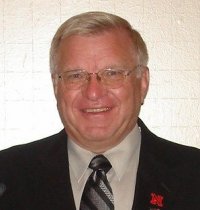The Mass of Christian Burial was held Wednesday, 10:00 a.m., December 31, 2014 at the Sacred Heart Catholic Church in Red Cloud with Rev. Paul Frank officiating. Interment was at the Red Cloud Cemetery. The rosary was recited Tuesday, 7:00 p.m. at the Williams Funeral Home.
Memorials are suggested in lieu of flowers to the 10th Judicial District Adoption Day in Hastings.
The son of Phyllis and Stan Offner, Mike was born November 18, 1952 at Hastings, Nebraska. He grew up in the Red Cloud community and attended the Red Cloud schools. Mike excelled at sports and was selected his senior year to participate and play in the 1971 Shrine Bowl. He attended the University of Nebraska at Lincoln on a full academic and football scholarship. Following the completion of his undergraduate studies, Mike was accepted into the University of Nebraska Law School, graduating in two and a half years.
Mike was united in marriage with Janet Pospichal in 1975. This union was blessed with two sons, Adam and Andrew. They have made their home in the Red Cloud community since 1977. He was a member of the Sacred Heart Catholic Church where he was a church lector and parish board member. Mike was a past president and treasurer of the Red Cloud Lions Club, the Chamber of Commerce, the Red Cloud Golf Course and the Red Cloud Ball Association. A strong supporter and advocate of community youth activities, Mike announced for many years at the local high school football games and also coached youth baseball for many years.
Left to treasure his memory are his wife, Janet Offner of Red Cloud; sons, Adam Offner and wife Darah and children Faith, Levi and Rose; Andrew Offner and wife Beth and children Devon, Skye, Caleb, JJ and Harper; his parents, Phyllis and Stan Offner of Red Cloud; a brother Steve Offner and wife Susan; sister Shelley Clayburn and husband Neal; sisters-in-law Lori Rock and husband Dean and Mary Pat Uacek and husband Don. Eveyone who knew Mike knows how much he cherished his grandchildren and loved attending all of their activities and photographing all of their events. Also surviving are his nieces, nephews, aunts, uncles, his colleagues and peers of the 10th District, as well as a host of friends who had the pleasure to know him who will deeply miss Mike.
Mike was involved in numerous professional activities, included:
Judgeship
2001 – present
Judge of the County Court, 10th Judicial District
Judge of the County Court, 10th Judicial District
(Adams, Clay, Fillmore, Franklin, Harlan, Kearney, Nuckolls, Phelps, & Webster counties)
2004 – 2005, 2009 – 2012
Presiding Judge of the 10th Judicial District, County Court
Experience
1978 - 2001
Private practice of law - Red Cloud, NE
1983 – 2001
Webster County Attorney’s Office, county attorney - Red Cloud, NE
1981 – 2001
Midland Area Agency on Aging, legal services attorney
1988 – 2001
City Attorney - Blue Hill, NE
Education
University of Nebraska College of Law, 1977
Juris Doctorate
University of Nebraska-Lincoln, 1975
Bachelor of Arts
Judicial/Law Related Activities
Professional Affiliations
Nebraska State Bar Association
10th Judicial District Bar Association
Nebraska County Judges Association
Nebraska Supreme Court Committees
Pro Se Committee and Forms Subcommittee, 2010-Present
National Reunification Day, host judge, 2010
South Central Nebraska Foster Youth Council, lead judge, 2009 – 2010
Court Representative appointed by UNK Chancellor to the Nebraska Safety Center Advisory Council, University of Nebraska-Kearney, 2008 - present
Dispute Resolution Advisory Council, member, 2008 – present
Through the Eyes of the Child Initiative, lead judge 10th District-Webster and Nuckolls County, 2006 – present
Adoption Day Committee, lead judge 10th Judicial District, 2005 – present
Juvenile Court Review Panel, 2004 – 2010
JUSTICE Automation Advisory Committee for Juvenile Courts, 2012-Present
Community Activities
Fillmore, Clay, and Webster County Government Day Mock Trial Competition, volunteer judge, 2005 – present
Bar Foundation Law Day Job Shadowing for 5th Graders in Nuckolls and Webster counties, 2013-Present
Honors and Awards
Nebraska Supreme Court Outstanding Judge
2009 recipient, Outstanding Judge for Service to the Judiciary Award. Outstanding Judge is the highest honor given by the Chief Justice to recognize members of the judiciary for meritorious projects and exemplary accomplishments that enhances the vision of justice within Nebraska communities.
Mary L. Buford Legal Services Award for outstanding services to elderly Nebraskans, presented by the Nebraska Department of Aging, 1992
Nebraska State Bar Foundation Fellow (2011)
An honor based on integrity and character. The Foundation recognizes established legal professionals who are dedicated to improving the administration of justice. Fellows are accredited by colleagues as leaders of the legal profession who contribute to the charitable and community education works of the Foundation.
Teaching & Publishing
Organizing Judge, Through the Eyes of the Child Lecture Series, “Improving Outcomes for Older Youth,” Hastings, 2010
Speaker, Technology in Rural Courts. At Kansas Judge's Spring Conference Meeting, 2010
Speaker, “A Network Approach,” Improving Rural Courts Seminar, 2009
Panelist, Through the Eyes of the Child Initiative, Regional Conference, 2008
Panel Speaker, District & County Judges Fall Educational Meeting, 2006
Panel Speaker, Leadership Program of the Hastings Chamber of Commerce, 2005 – 2008, 2010
Annual Speaker, various area County Government Days and High School Government Classes, 2004 – present
Speaker, Nebraska CASA Association Annual Volunteer Conference, 2003
Speaker, Library Broadband Builds Nebraska Community Project at Auld Public Library-Red Cloud, 2011
Speaker, NSBA/Leadership Academy Community Service and Bar Governance Workshop, 2012
Williams Funeral Home241 West 4th Avenue
Red Cloud, Nebraska 68970
402-746-2500



